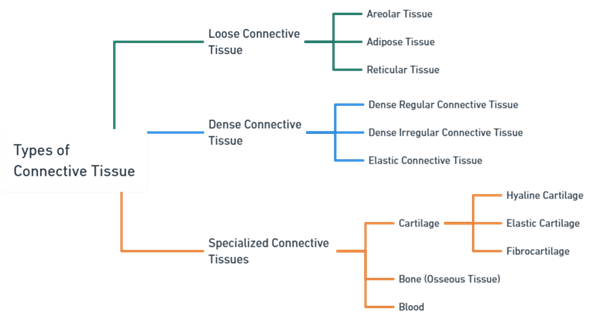- Connective tissues provide support, protection, and structure to the body.
Types of Connective Tissues
Advertisements
Loose Connective Tissue
Areolar Tissue
- Structure: Contains a loose arrangement of fibers and various cell types.
- Location: Widely distributed under epithelia, surrounds capillaries.
- Function: Provides cushioning, binds tissues, and allows for nutrient diffusion.
Adipose Tissue
- Structure: Comprised mainly of adipocytes filled with fat droplets.
- Location: Under the skin (subcutaneous layer), around kidneys and eyeballs, within the abdomen, and in breasts.
- Function: Stores energy insulates against heat loss, and cushions organs.
Advertisements
Reticular Tissue
- Structure: Network of reticular fibers with supportive cells.
- Location: Lymphoid organs (lymph nodes, bone marrow, and spleen).
- Function: Provides a supportive framework for soft organs.
Dense Connective Tissue
Regular Connective Tissue (Dense)
- Structure: Parallel collagen fibers with a few elastic fibers; major cell type is fibroblasts.
- Location: Tendons, ligaments, and aponeuroses.
- Function: Attaches muscles to bones or to muscles and bones to bones; withstands great tensile stress in one direction.
Advertisements
Irregular Connective Tissue (Dense)
- Structure: Irregularly arranged collagen fibers with some elastic fibers; major cell type is fibroblasts.
- Location: Dermis of the skin, submucosa of digestive tract, fibrous capsules of organs and joints.
- Function: Withstands tension exerted in many directions; provides structural strength.
Elastic Connective Tissue
- Structure: Dense regular connective tissue containing a high proportion of elastic fibers.
- Location: Walls of large arteries, within certain ligaments associated with the vertebral column, within the walls of the bronchial tubes.
- Function: Allows tissue to recoil after stretching; maintains pulsatile flow of blood through arteries; aids passive recoil of lungs following inspiration.
Specialized Connective Tissues
Cartilage
Hyaline Cartilage:
Advertisements
- Structure: Amorphous but firm matrix with collagen fibers; chondrocytes lie in lacunae.
- Location: Embryonic skeleton ends of long bones in joint cavities, costal cartilages of the ribs, nose, trachea, and larynx.
- Function: Supports and reinforces; serves as a resilient cushion; resists compressive stress.
Elastic Cartilage:
- Structure: Similar to hyaline cartilage, but more elastic fibers in matrix.
- Location: External ear (pinna), epiglottis.
- Function: Maintains the shape of a structure while allowing great flexibility.
Advertisements
Fibrocartilage:
- Structure: Matrix similar to but less firm than that in hyaline cartilage; thick collagen fibers predominate.
- Location: Intervertebral discs, pubic symphysis, discs of knee joint.
- Function: Tensile strength allows it to absorb compressive shock.
Bone (Osseous Tissue):
- Structure: Hard, calcified matrix containing many collagen fibers; osteocytes lie in lacunae. Very well vascularized.
- Location: Bones
- Function: Supports and protects (by enclosing); provides levers for the muscles to act on; stores calcium and other minerals and fat; marrow inside bones is the site for blood cell formation (hematopoiesis).
Advertisements
Blood:
- Structure: Red and white blood cells in a fluid matrix (plasma).
- Location: Contained within blood vessels.
- Function: Transports respiratory gases, nutrients, wastes, and other substances.
Structure
- Connective tissues have fewer cells and more extracellular matrix than other tissues.
- The extracellular matrix consists of protein fibers (collagen, elastin, reticular) and ground substance.
Advertisements
Location
- Connective tissue proper: Beneath the skin, around organs, tendons, ligaments, and bone marrow.
- Specialized connective tissue: Joints, rib cage, ear, and skeletal system.
- Fluid connective tissue: Blood vessels and lymphatic vessels.
Functions
- Support: Connective tissues bind and support other tissues and organs.
- Protection: They protect and cushion organs.
- Insulation: Adipose tissue stores energy and insulates the body.

